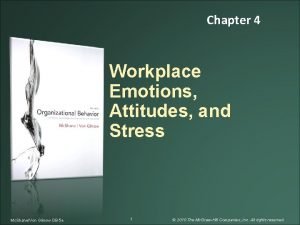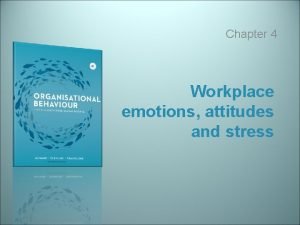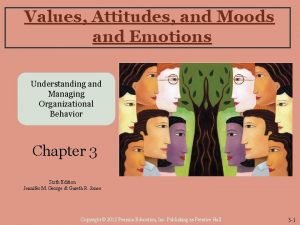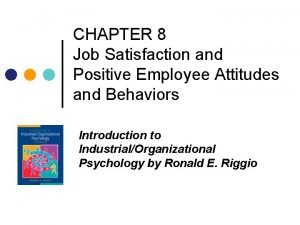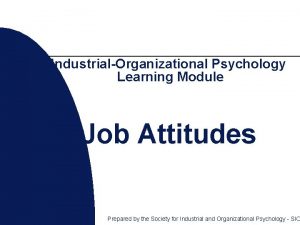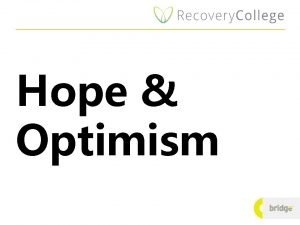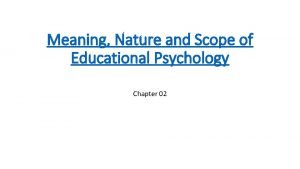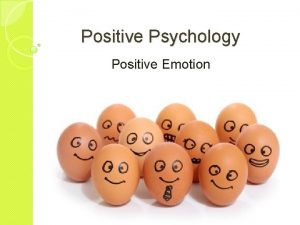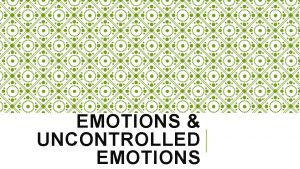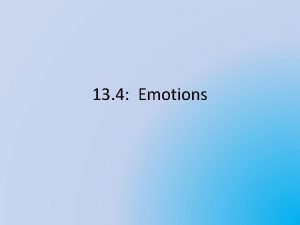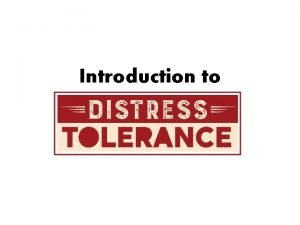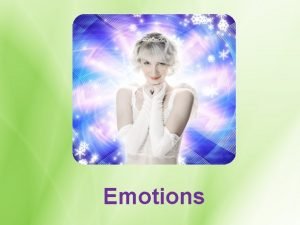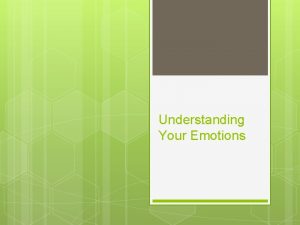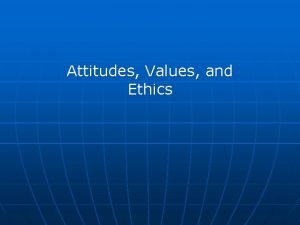Positive Psychology Positive Attitudes and Health Positive emotions













- Slides: 13

Positive Psychology

Positive Attitudes and Health Positive emotions predict better health Higher levels of hope associated with reduced risk of disease Higher levels of curiosity associated with reduced risk of hypertension and diabetes Positive emotion enhances immune system functioning and life expectancy

What is happiness? Martin Seligman (2002) Authentic Happiness vs. Satisfaction A person who is satisfied is not concerned with his or her mood 3 components of satisfaction: Pleasure/Pleasant life Engagement/Good life Gratification/Meaningful life

The Pleasant Life The search for flavor Focuses on physical sensations Taste, smell, sight, sound, touch Habituation You can avoid it Let time go by Limit exposure Mindfulness

The Good Life Get in the flow Total absorption in what you’re doing Goal is absorption rather than pleasure Lose yourself in the task 8 steps to achieving the flow Factors that influence flow: The level of proficiency of the individual The level of difficulty of the activity

The Good Life “Enjoyment appears at the boundary between boredom and anxiety, when the challenges are just balanced with the person’s capacity to act. ” High flow is associated with higher self esteem Low flow is associated with more fun (e. g. hanging out)

The Meaningful Life Find a good fit between who you are and what your associates expect from you Identify your strengths and weaknesses We must understand how we are similar and different from others in four areas: • • Behavioral traits Mental abilities Physical characteristics Memory

Things associated with increased happiness: Living in a democracy rather than a dictatorship Marriage Avoiding negative events and emotions Social networks Social integration Emotional disclosure Spirituality

Things not associated with increased happiness (myths): Making more money and getting more stuff Pursuing physical health through surgery, drugs, doctor visits Increasing your perceived beauty (e. g. cosmetic surgery) Pursing education for its own sake Changing apparent race Living in a different climate (sunnier, cooler, dryer, etc. )

Happiness in the Brain Happiness seen in left prefrontal lobe electrical activity Pleasure seen in the limbic region You want BOTH Happiness is pleasure + meaning and mental engagement.

What makes happiness? Happiness Your is made up of a combination of: nature Your circumstances Factors under your control

Getting past anger: R. E. A. C. H. Recall someone’s hurt to you objectively, descriptively, without judging Empathize by trying to understand the perpetrator’s possible reasons for the act that caused injury Altruistically forgive the person, beginning by recalling an incident in which someone forgave you for an injury you may have caused Commit publicly by writing a note, poem, song, or other tangible or visible remembrance of your forgiving act Hold onto this forgiving stance – reread your note. No need to try to forget the injury, but focus on remembering the forgiving of it.

Try for yourself! Write a letter of gratitude and deliver it in person to someone who has been kind to you but whom you have never thanked. Every night, write down three things that went well that day and explain why they went well. Write about a time when you did your very best, and then think about the strengths you displayed. Review this story every night for the next week. Imagine yourself 10 years in the future as your best possible self, as having achieved all your most important goals. Describe in writing what your life is like and how you got there. Keep a journal in which you write about the positive aspects of your life. Reflect on your health, freedom, friends, and so on. Act like a happy person. Sometimes just going through the motions of being happy with create happiness.
 Workplace emotions attitudes and stress
Workplace emotions attitudes and stress Workplace emotions, attitudes, and stress
Workplace emotions, attitudes, and stress Values attitudes moods and emotions
Values attitudes moods and emotions Positive employee attitudes and behaviors
Positive employee attitudes and behaviors Positive psychology ap psychology definition
Positive psychology ap psychology definition Attitudes in psychology
Attitudes in psychology Attitude definition psychology
Attitude definition psychology The broaden-and-build theory of positive emotions
The broaden-and-build theory of positive emotions Health psychology definition ap psychology
Health psychology definition ap psychology James lange
James lange Attitude is everything quote
Attitude is everything quote Write the meaning of educational psychology
Write the meaning of educational psychology Health and social component 3
Health and social component 3 Module 74 attribution attitudes and actions
Module 74 attribution attitudes and actions
